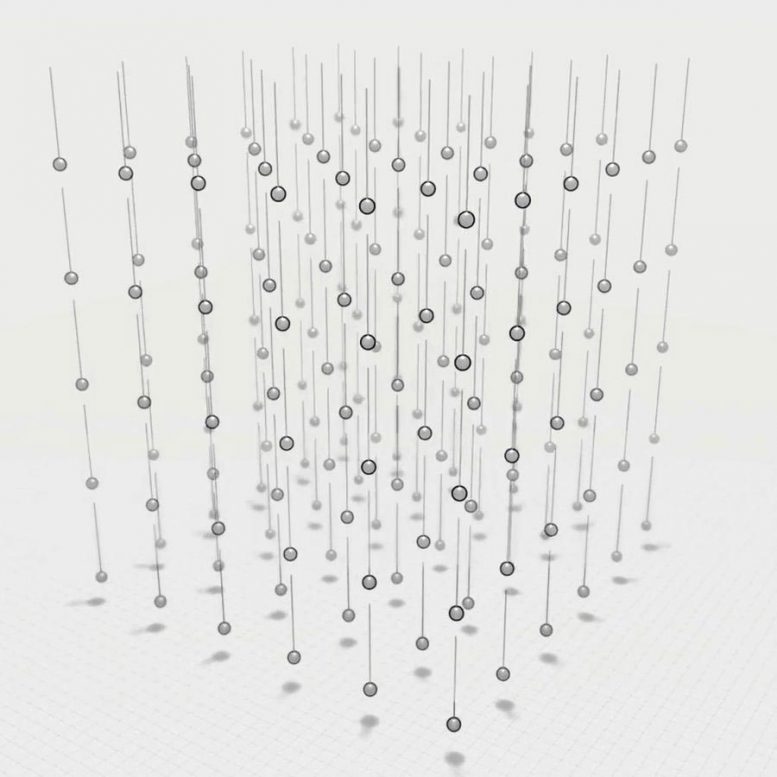Image Credit: NIST
Researchers have proposed a novel method for finding dark matter.
Researchers at the National Institute of Standards and Technology (NIST) and their colleagues have proposed a novel method for finding dark matter, the mysterious material of the cosmos that has eluded discovery for decades. Dark matter makes up about 27% of the universe; Ordinary matter, like the stuff that builds stars and planets, makes up only 5% of the cosmos. (A mysterious entity called dark energy makes up the other 68%.)
According to cosmologists, all of the visible material in the universe just floats in a huge sea of dark matter – particles that are invisible but still have mass and exert a gravitational force. Dark matter’s gravity would provide the missing glue that prevents galaxies from falling apart and explain how matter is clumped together to form the universe’s rich galactic tapestry.
The proposed experiment, in which a billion-sized pendulum would act as a sensor for dark matter, would be the first to look for dark matter solely through its gravitational interaction with visible matter. The experiment would be one of the few looking for particles of dark matter with a mass as large as that of a grain of salt. This scale is seldom explored and never examined by sensors that can record tiny gravitational forces.
Dark matter, the hidden stuff of our universe, is notoriously difficult to discover. Looking for direct evidence, NIST researchers have proposed using a 3-D array of pendulums as force detectors that could detect the gravitational influence of passing dark matter particles. When a dark matter particle is near a floating pendulum, the pendulum should deflect slightly due to the attraction of both masses. However, this force is very small and difficult to isolate from ambient noise causing the pendulum to move. To better isolate the distractions from passing particles, NIST researchers suggest using a pendulum array. Ambient noise affects each pendulum individually, causing it to move independently. However, particles passing through the array produce correlated deflections of the pendulums. Because these movements are correlated, they can be isolated from the background noise and show how much force a particle is exerting on each pendulum and how fast and in what direction or speed the particle is. Image Credit: NIST
Previous experiments have looked for dark matter by looking for non-gravitational signs of interactions between the invisible particles and certain types of ordinary matter. Such was the case with the search for a hypothetical type of dark matter called WIMP (weakly interacting massive particles), which was a leading candidate for the invisible material for more than two decades. Physicists looked for evidence that when WIMPs occasionally collide with chemical substances in a detector, they emit light or give off electrical charge.
Researchers looking for WIMPs this way have either left empty-handed or inconclusive. The particles are too light (theoretically, to have a mass between that of an electron and a proton) to be captured by their gravitational tug.
With the search for WIMPs seemingly in the last legs, researchers at NIST and their colleagues are now considering a more direct method of looking for dark matter particles that have a greater mass and therefore exert a gravitational force large enough to to be captured.
“Our proposal is based entirely on gravitational coupling, the only coupling we know with certainty between dark matter and ordinary luminous matter,” said study co-author Daniel Carney, a theoretical physicist who collaborates with NIST, the Joint Quantum Institute (JQI, who is affiliated with) and the Joint Center for Quantum Information and Computer Science (QuICS) at the University of Maryland in College Park and the Fermi National Accelerator Laboratory.
The researchers, which includes Jacob Taylor of NIST, JQI, and QuICS; Sohitri Ghosh from JQI and QuICS; and Gordan Krnjaic of the Fermi National Accelerator Laboratory calculate that their method can search for dark matter particles with a minimum mass about half the size of a grain of salt or about a billion billion times that of a proton. The scientists reported their results on October 13, 2020 in Physical examination D..

Dark matter, the hidden stuff of our universe, is notoriously difficult to discover. Looking for direct evidence, NIST researchers have suggested using a 3-D array of pendulums as force detectors that could detect the gravitational influence of passing dark matter particles. Image Credit: NIST
Since the only unknown in the experiment is the mass of the dark matter particle, and not as it associates with ordinary matter, “someone setting up the experiment we propose will either find dark matter or rule it out all Candidates for dark matter across a wide range of possible masses, ”said Carney. The experiment would be sensitive to particles ranging from about 1 / 5,000 milligrams to a few milligrams.
This mass scale is particularly interesting because it covers the so-called Planck mass, an amount of mass that is determined exclusively by three basic constants of nature and corresponds to about 1 / 5,000 grams.
Carney, Taylor and their colleagues propose two schemes for their gravitational experiment with dark matter. Both are tiny, millimeter-sized mechanical devices that act as extremely sensitive gravitational detectors. The sensors would be cooled to temperatures just above this Absolute zero to minimize heat-related electrical interference and protect against cosmic rays and other sources of radioactivity. In one scenario, a large number of highly sensitive pendulums would each deflect slightly in response to the pulling of a passing particle of dark matter.
Similar devices (with much larger dimensions) have been used in the recent Nobel Prize winning detection of Gravitational wavesWaves in the space-time structure, which are predicted by Einstein’s theory of gravity. Carefully hanging mirrors that act like pendulums move less than the length of one atom in response to a passing gravitational wave.
In another strategy, the researchers suggest using spheres that float through a magnetic field or pearls that float through laser light. In this scheme, levitation is switched off at the beginning of the experiment so that the balls or pearls are in free fall. The gravity of a passing particle of dark matter would only slightly disturb the path of the freely falling objects.
“We use the movement of objects as our signal,” said Taylor. “This is different from virtually every particle physics detector out there.”
The researchers calculate that an array of roughly a billion tiny mechanical sensors, spread over a cubic meter, is required to distinguish a real dark matter particle from an ordinary particle or interfering random electrical signals or “noise”, the one Trigger false alarms in the sensors. Ordinary subatomic particles like neutrons (which interact through a non-gravitational force) would stall in a single detector. In contrast, scientists expect a dark matter particle, which passes the array like a miniature asteroid, to wobble each detector one by one on its way through gravity.
Noise would cause individual detectors to move randomly and independently rather than sequentially, as would be the case with dark matter particles. As a bonus, the coordinated movement of the billions of detectors would indicate the direction the dark matter particle was moving as it zoomed through the array.
To make so many tiny sensors, the team suggests that researchers want to borrow techniques that the smartphone and automotive industries are already using to make large numbers of mechanical detectors.
Thanks to the sensitivity of the individual detectors, researchers using this technology do not have to limit themselves to the dark side. A smaller version of the same experiment could capture the weak forces of distant seismic waves, as well as those of the passage of common subatomic particles such as neutrinos and single low-energy photons (light particles).
The smaller-scale experiment could even look for dark matter particles – if they give the detectors a big enough kick through a non-gravitational force, as some models predict, Carney said.
“We have the ambitious goal of building a gravitational dark matter detector, but the research and development required to do this would open the door to many other detection and measurement measurements,” said Carney.
Researchers from other institutions have already started pre-testing the NIST team’s design.
Reference: “Proposal for direct gravitational detection of dark matter” by Daniel Carney, Sohitri Ghosh, Gordan Krnjaic and Jacob M. Taylor, October 13, 2020, Physical examination D..
DOI: 10.1103 / PhysRevD.102.072003



